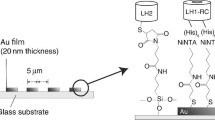Summary
Bacterial chromatophores have been isolated from a purple non-sulfur bacterium (Rhodopseudomonas capsulata) by sonication and immobilized within various supports. In each case, the activity yield after immobilization and the storage stability (under dark conditions at 4°C) have been determined. Some preliminary comparative experiments concerning the ATP production in a batch reactor are presented for native and immobilized chromatophores.
Similar content being viewed by others
References
Clayton RK (1963) Toward the isolation of a photobiochemical reaction center in Rhodopseudomonas sphaeroides. Biochem Biophys Acta 75:312–323
Cocquempot MF, Thomasset B, Barbotin JN, Gellf G, Thomas D (1981) Comparative stabilization of biological photosystems by several immobilization procedures: 2. Storage and functional stability of immobilized thylakoids. Eur J Appl Microbiol Biotechnol in press
Fan IJ, Chien YC, Chiang IH (1978) The inorganic photoreduction of NAD to NADH and photophosphorylation of ADP to ATP in visible light. Sci Sin 21:663–668
Frenkel AW (1954) Light induced photophosphorylation by cell free preparations of photosynthetic bacteria. J Am Chem Soc 76:5568–5569
Fukui S, Tanaka A, Iida T, Hasegawa E (1976) Application of photo-crosslinkable resin to immobilization of an enzyme. FEBS Lett 66:179–182
Fukushima S, Nagai T, Fujita K, Tanaka A, Fukui S (1978) Hydrophilic urethan prepolymers: convenient material for enzyme entrapment. Biotechnol Bioeng 20:1465–1469
Hackel V, Klein J, Megnet R, Wagner F (1975) Immobilization of microbial cells in polymeric matrices. Eur J Appl Microbiol Biotechnol 1:291–294
Hillmer P, Gest H (1977) H2 metabolism in the photosynthetic bacterium Rhodopseudomonas capsulata: H2 production by growing cultures. J Bacteriol 129:724–731
Hochman A, Carmeli C (1977) Reconstitution of photosynthetic electron transport and photophosphorylation in cytochrome-c2 deficient membrane of Rhodopseudomonas capsulata. Arch Biochem Biophys 179:349–359
Kierstan M, Bucke C (1977) The immobilization of microbial cells, subcellular organelles and enzymes in calcium alginate gels. Biotechnol Bioeng 19:387–397
Lamprecht W, Trautschold I (1974) Determination with hexokinase and glucose-6-phosphate dehydrogenase. Bergmeyer HU (ed) Methods of enzymatic analysis. Academic Press, New York, 4:2101–2109
Langer RS, Hamilton BK, Gardner MC, Archer MC, Colton CK (1976) Enzymatic regeneration of ATP. 1. Alternative routes. AIChE J 22:1079–1090
Larreta Garde V, Cocquempot MF, Barbotin JN, Thomasset B, Thomas D (1980) Immobilized thylakoids and chromatophores: hydrogen production and ATP regeneration. Enzyme Eng 5:109–118
Marshall DL (1973) ATP regeneration using immobilized carbamyl phosphokinase. Biotechnol Bioeng 15:447–453
Murata K, Tani K, Kato J, Chibata I (1980) Continuous production of glutathione using immobilized microbial cells containing ATP generating system. Biochimie 62:347–353
Ohlson S, Larsson P, Mosbach K (1979) Steroid transformation by living cells immobilized in calcium alginate. Eur J Appl Microbiol Biotechnol 7:103–110
Pace GW, Yang HS, Tannenbaum SR, Archer MC (1976) Photosynthetic regeneration of ATP using bacterial chromatophores. Biotechnol Bioeng 18:1413–1423
Paul F, Vignais PM (1980) Photophosphorylation in bacterial chromatophores entrapped in alginate gel: improvement of the physical and biochemical properties of gel beads with barium as gel inducing agent. Enzyme Microb Technol 2:281–287
Pfenning N (1978) General physiology and ecology of photosynthetic bacteria. Clayton RK, Sistrom WR (eds) The photosynthetic bacteria. Plenum Press, New York, pp 3–18
Takata I, Yamamoto K, Tosa T, Chibata I (1979) Screening of microorganisms having high fumarase activity and their immobilization with carrageenan. Eur J Appl Microbiol Biotechnol 7:161–172
Tochikura T, Kuwahara M, Yagi S, Okamoto H, Tominaga Y, Kano T, Ogata K (1967) Fermentation and metabolism of nucleic acid related compounds in yeast. J Ferment Technol 45:511
Wada M, Kato J, Chibata I (1979) A new immobilization of microbial cells. Immobilized growing cells using carrageenan gel and their properties. Eur J Appl Microbiol Biotechnol 8:241–247
Weaver PF, Wall JD, Gest H (1975) Characterization of Rhodopseudomonas capsulata. Arch Microbiol 105:207–216
Yang HS, Leung KH, Archer MC (1976) Preparation and properties of bacterial chromatophores entrapped in polyacrylamide. Biotechnol Bioeng 18:1425–1432
Author information
Authors and Affiliations
Rights and permissions
About this article
Cite this article
Larreta Garde, V., Thomasset, B., Tanaka, A. et al. Comparative stabilization of biological photosystems by several immobilization procedures. European J. Appl. Microbiol. Biotechnol. 11, 133–138 (1981). https://doi.org/10.1007/BF00511250
Received:
Issue Date:
DOI: https://doi.org/10.1007/BF00511250




